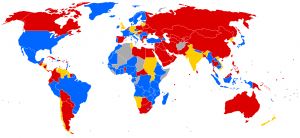The Impact of HIV on the The Haitian Refugee Crisis

Map of HIV travel restrictions. By Made by Verdy p 18:25, 11 December 2007 (UTC), via Wikimedia Commons
People fear what they do not understand. Few things were less understood or more feared in the late ’80’s than HIV. Though everyone knew that HIV killed, how it spread was still unclear to many Americans. How long it stayed dormant before turning into AIDS was still unknown to most doctors. So little was known about the new disease that no one was really sure what to call it. Before pathologists settled on Human Immunodeficiency Virus the disease went through many names. Some even called it 4H after what many people believed were the four most commonly infected groups: homosexuals, hemophiliacs, heroin users, and Haitians.
The United States was already wary of refugees before the Haitian Refugee Crisis. The Immigration and Naturalization Service had been tasked with keeping unwanted people out of the country since 1933. Thousands of Haitians fled their home in the wake of the 1991 coup d’etat. Some of these Haitians were not just refugees, however. They were carriers of a deadly plague. Misinformation and hysteria had led many Americans to believe that HIV had come to the United States via Haiti, when in truth it was probably the other way around. In the mind of the American public, Haitians were the “patient zero” of a new and deadly plague, one that could not be allowed to encroach further into the United States.
Congress had passed a law in 1987 barring anyone found to be HIV positive from immigrating to the United States. Consequently, Haitians seeking to enter the United States and forced into Guantánamo Bay were required to take an HIV test as part of the screening process. Over 250 Haitian men, women, and children were deemed political refugees and thus could not be sent to Haiti. But since they were also HIV positive, they were barred entrance into the United States. With no where to go Camp Bulkeley in Guantánamo Bay became their prison for almost three years. It was the first and possibly only HIV/AIDS detention center in the world.
Having committed no crime and posing no real threat, these Haitians, with their already weakened immune systems, were given inadequate shelter, rotting food, and almost no medical attention. It is astounding more of them did not die in the camp. To protest, the detainees went on a hunger strike. Thousands of students at Yale, Harvard, and institutions around the country joined in. Susan Sarandon and Tim Robbins used their time in the spotlight at the 1993 Academy Awards to bring the Haitian refugees crisis to the public’s attention. Only after all of this were the sick Haitians allowed to enter the United States.
While this certainly hasn’t been the only time a disease has been used as an excuse to persecute or detain people it is one of the more unsettling incidents in recent memory. The people of the United States like to think they can hold their government to a higher moral standard than this. By 1993, Americans were shocked to find how low our standards had gone. Now, 20 years later, people are still held at Guantánamo Bay without due process, leaving one to wonder if we’ve made any progress at all.
Posted by Daniel Neff – MA Candidate at Northeastern University
